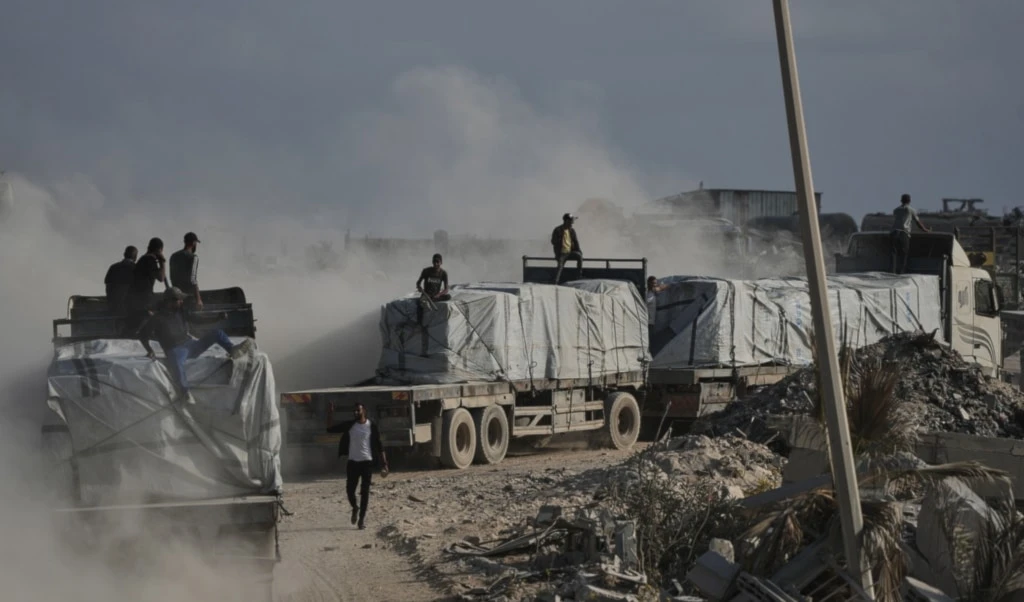Flooded Gaza camps deepen suffering for displaced families
Heavy rain floods Gaza displacement camps, leaving families in desperate conditions as authorities call for urgent shelter and humanitarian aid.
-

Salam Musa, 9, carries a mattress as he walks between tents after rainfall at a temporary camp in Deir al-Balah, in the central Gaza Strip, on Friday, November 14, 2025 (AP)
Heavy rainfall has deepened the suffering of displaced Palestinians in the Gaza Strip, where thousands of makeshift tents were inundated on Friday, prompting urgent rescue calls to the Civil Defense.
The Civil Defense in Gaza confirmed it has received continuous distress calls from early morning, as tents collapsed and flooded with rainwater in camps and shelters scattered across multiple areas. The most severe cases were recorded in Gaza City, particularly in al-Nafaq, al-Daraj, al-Yarmouk, al-Zaytoun, and the al-Shati refugee camp.
The situation was similarly dire in the central governorate, including al-Baraka and al-Bassa in Deir al-Balah, near the Islamic Bank on Salah al-Din Street west of al-Bureij camp, and in displacement sites surrounding the Nuseirat market area.
With winter conditions arriving and infrastructure destroyed by months of bombardment, civil defense authorities urged immediate international intervention. It appealed specifically to countries overseeing the ceasefire negotiations in Gaza to take responsibility for the humanitarian disaster affecting nearly half a million families uprooted by what it described as the Israeli occupation’s ongoing war of extermination.
The Civil Defense stressed that these families are living in extremely harsh conditions inside overcrowded displacement camps and temporary shelters, demanding the urgent entry of caravans, housing units, and weather-resistant tents to prevent further catastrophe as temperatures drop.
Thousands without shelter
Hamas also warned that the camps have “turned into pools of mud,” leaving thousands without any protection from the cold. The movement said the scenes reflect “the escalating suffering endured by the Palestinian people in the Strip,” and highlight the urgent need for shelter and relief supplies.
It condemned the Israeli occupation for continuing to obstruct the entry of humanitarian aid, including tents and prefabricated housing, and called on the UN, the guarantors of the ceasefire, the Arab League, and the Organization of Islamic Cooperation to move swiftly to deliver food, medical support, and emergency shelter to Gaza.
Hamas further urged greater field, popular, and official support to ensure displaced families are protected and provided basic human needs amid what it described as a catastrophic reality imposed by the Israeli occupation.
Khan Younis warns 900,000 displaced
The spokesperson for the Khan Younis Municipality, Saeb Laqqan, warned that more than 900,000 displaced Palestinians are currently living in makeshift tents in the coastal al-Mawasi area, expressing deep concern for their safety as a weather depression approaches.
Laqqan stressed the urgent need to pressure the Israeli occupation to allow the entry of essential equipment required by the municipality to carry out its work and secure the displaced population in these emergency conditions.
Al Mayadeen’s correspondent in the Gaza Strip had reported that Israeli warplanes launched two airstrikes southeast of Khan Younis, in the southern part of the besieged territory. The strikes coincided with gunfire from Israeli tanks positioned south of the city.
'Israel' continues to violate the ceasefire in Gaza
Hamas accused "Israel" of daily violations of the ceasefire agreement signed in Sharm el-Sheikh nearly a month ago, holding it fully responsible for undermining the deal and seeking to derail it.
On November 11, the Government Media Office in Gaza published horrifying statistics detailing the Israeli violations committed since the ceasefire was reached on October 10. According to figures compiled by the office, "Israel" committed 282 ceasefire violations during this period, killing 242 Palestinians and injuring 620 others.
The documentation details a broad range of violations, including 88 shooting incidents targeting civilians, 12 incursions into residential areas beyond the yellow-line buffer zone, 124 airstrikes and attacks, 52 demolitions of civilian homes, and the arrest of 23 Palestinians across the Gaza Strip.

 4 Min Read
4 Min Read










